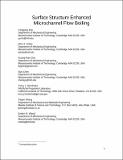| dc.contributor.author | Zhu, Yangying | |
| dc.contributor.author | Antao, Dion Savio | |
| dc.contributor.author | Chu, Kuang-Han | |
| dc.contributor.author | Chen, Siyu | |
| dc.contributor.author | Hendricks, Terry J. | |
| dc.contributor.author | Zhang, Tiejun | |
| dc.contributor.author | Wang, Evelyn N. | |
| dc.date.accessioned | 2016-06-08T16:07:59Z | |
| dc.date.available | 2016-06-08T16:07:59Z | |
| dc.date.issued | 2016-05 | |
| dc.date.submitted | 2016-03 | |
| dc.identifier.issn | 0022-1481 | |
| dc.identifier.uri | http://hdl.handle.net/1721.1/103058 | |
| dc.description.abstract | We investigated the role of surface microstructures in two-phase microchannels on suppressing flow instabilities and enhancing heat transfer. We designed and fabricated microchannels with well-defined silicon micropillar arrays on the bottom heated microchannel wall to promote capillary flow for thin film evaporation while facilitating nucleation only from the sidewalls. Our experimental results show significantly reduced temperature and pressure drop fluctuation especially at high heat fluxes. A critical heat flux (CHF) of 969 W/cm2 was achieved with a structured surface, a 57% enhancement compared to a smooth surface. We explain the experimental trends for the CHF enhancement with a liquid wicking model. The results suggest that capillary flow can be maximized to enhance heat transfer via optimizing the microstructure geometry for the development of high performance two-phase microchannel heat sinks. | en_US |
| dc.description.sponsorship | United States. Office of Naval Research (N00014-15-1-2483) | en_US |
| dc.description.sponsorship | Masdar Institute of Science & Technology - MIT Technology & Development Program (Cooperative agreement, Reference 02/MI/MI/CP/11/07633/GEN/G/00) | en_US |
| dc.description.sponsorship | United States. Air Force Office of Scientific Research | en_US |
| dc.description.sponsorship | Battelle Memorial Institute | en_US |
| dc.description.sponsorship | Singapore-MIT Alliance for Research and Technology (SMART) | en_US |
| dc.language.iso | en_US | |
| dc.publisher | American Society of Mechanical Engineers (ASME) | en_US |
| dc.relation.isversionof | http://dx.doi.org/10.1115/1.4033497 | en_US |
| dc.rights | Creative Commons Attribution-Noncommercial-Share Alike | en_US |
| dc.rights.uri | http://creativecommons.org/licenses/by-nc-sa/4.0/ | en_US |
| dc.source | MIT web domain | en_US |
| dc.title | Surface Structure Enhanced Microchannel Flow Boiling | en_US |
| dc.type | Article | en_US |
| dc.identifier.citation | Zhu, Yangying, Dion S. Antao, Kuang-Han Chu, Siyu Chen, Terry J. Hendricks, Tiejun Zhang, and Evelyn N. Wang. “Surface Structure Enhanced Microchannel Flow Boiling.” Journal of Heat Transfer 138, no. 9 (May 17, 2016): 091501. | en_US |
| dc.contributor.department | Massachusetts Institute of Technology. Department of Mechanical Engineering | en_US |
| dc.contributor.approver | Wang, Evelyn, N. | en_US |
| dc.contributor.mitauthor | Zhu, Yangying | en_US |
| dc.contributor.mitauthor | Antao, Dion Savio | en_US |
| dc.contributor.mitauthor | Chu, Kuang-Han | en_US |
| dc.contributor.mitauthor | Chen, Siyu | en_US |
| dc.contributor.mitauthor | Zhang, Tiejun | en_US |
| dc.contributor.mitauthor | Wang, Evelyn N. | en_US |
| dc.relation.journal | Journal of Heat Transfer | en_US |
| dc.eprint.version | Author's final manuscript | en_US |
| dc.type.uri | http://purl.org/eprint/type/JournalArticle | en_US |
| eprint.status | http://purl.org/eprint/status/PeerReviewed | en_US |
| dspace.orderedauthors | Zhu, Yangying; Antao, Dion S.; Chu, Kuang-Han; Chen, Siyu; Hendricks, Terry J.; Zhang, Tiejun; Wang, Evelyn N. | en_US |
| dspace.embargo.terms | N | en_US |
| dc.identifier.orcid | https://orcid.org/0000-0001-9185-3161 | |
| dc.identifier.orcid | https://orcid.org/0000-0003-4165-4732 | |
| dc.identifier.orcid | https://orcid.org/0000-0001-7045-1200 | |
| mit.license | OPEN_ACCESS_POLICY | en_US |
